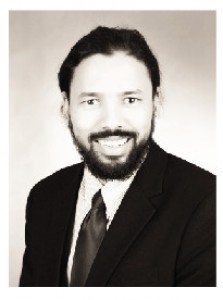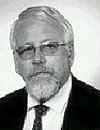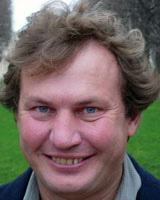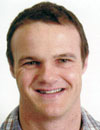Introduction
In 1978, the World Health Organisation (WHO) held an international conference at Alma Ata to raise global awareness and interest in primary health care. Optimizing primary health care was identified as the most important intervention to achieve the goal of 'Health for all by the year 2000'1,2. Since then there has been considerable attention to the redevelopment and refinement of concepts such as 'general practice' and 'family medicine'1,3-5. Healthcare systems in many countries have been reformed, assigning a more prominent role to primary health care and the general medical practitioner6-12. Based on these and other significant developments13, family medicine is now recognized as a specialty discipline in South Africa, with family medicine practitioners being called 'family physicians'14.
In keeping with expectations regarding the role of family physicians, South Africa and many other countries have increased the amount of undergraduate medical teaching that takes place outside tertiary-level training hospitals1,15-16. During the 1970s, ambulatory settings were already suggested for training of medical students17, and the functions of a family medicine preceptorship was studied in the years 1976-197718. Following these developments, a model using local health centres in undergraduate medical education was proposed19. Internationally, primary health care centres (PHCC, or 'clinics') and district level general hospitals, both urban and rural, subsequently became the settings of choice for training undergraduate medical students20-22.
In January 1998, a 2 week period ('rotation' or 'clerkship') of community-based training in the Division of Family Medicine and Primary Care (DFMPC) was introduced to the medical curriculum at the Faculty of Health Sciences (FHS), Stellenbosch University (SU)15, although community-based medical education had been offered in other disciplines, such as Obstetrics and Gynaecology, since the 1970s. Medical students rotated to urban PHCC within a 50 km radius of the faculty, and rated their experiences positively, in agreement with results reported in the international literature23-25. As a result, medical students at SU FHS were offered teaching opportunities during each of the three different phases of clinical training in the revised (since 1999) undergraduate curriculum: Early Clinical Rotations (3rd year students), Middle Clinical Rotations (4th and early 5th year students) and Late Clinical Rotations (late 5th and 6th year students). The Ukwanda Centre for Rural Health (www.sun.ac.za/ukwanda) was launched in June 2001, to further develop and maintain a clinical training platform at district level hospitals located in rural towns of the Western Cape Province.
Following the establishment of rural family medicine rotations for undergraduate medical students, it became imperative to assess the educational value of these rotations. Numerous assessment tools to evaluate students' theoretical knowledge and clinical skills acquisition (competence) have been described20,26-31. Log diaries were introduced as a data collection instrument to document accurately how students spend their time in various medical training environments; the value of this instrument has been substantiated in a number of studies32-35.
Due to the recent focus on community-based or rural clinical settings as preferred locations for clinical education, the goal of this study was to gain insight into students' experiences in such settings, both from academic and experiential points of view. Even with some evidence regarding the value of community-based rotations or clerkships in Africa36, the value of rural rotations has mainly been described in Canada, the USA and Australia37-42, with very limited evidence that indicates the unique value of undergraduate rural rotations in developing countries43. Specifically, the perceived educational value and enjoyment of such rural rotations have not been assessed together in a single study. The aim of this study, therefore, was to evaluate students' academic activities, together with the perceived educational value and enjoyment of a 2 week clinical rotation in a rural setting in South Africa, for medical students in their 4th or 5th year of study (Middle Clinical Rotations), using a log diary-based approach. Both quantitative and qualitative methods were used.
Methods
Setting
The study was conducted at Stellenbosch University's Faculty of Health Sciences, Cape Town, South Africa. As part of community-based medical education in practice, a pre-determined number of 4th and early 5th year medical students undergo a 2 week rural clinical rotation. This represents the first or second time in their undergraduate training that medical students leave the academic environment for medical training (some students experience a rotation away from the tertiary complex during their 3rd academic year, as part of the Early Clinical Rotation). During this Middle Clinical Rotation students complete written assignments and projects for three disciplines (combined into a single 2 week rotation): family medicine and primary care, rehabilitation and community medicine.
The rotation starts with an introductory lecture on Monday morning, after which students travel to their assigned rural setting. On arrival (by 14.00 h the same day) students are introduced to hospital/ clinic staff and receive a brief orientation. Arrangements for travelling and accommodation are facilitated by the Ukwanda Centre for Rural Health. Students return to the faculty 2 weeks later (on the final Friday) and present their experiences to a faculty supervisor.
Recruitment
Between July and September 2007 (second semester), 37 medical students, in their 4th or 5th academic year (MBChB IV/V) were invited to take part in the study. Each of these students rotated to a district level hospital at one of the following sites: Caledon, Ceres, Citrusdal, Hermanus, Malmesbury, Swellendam or Worcester. Local academic supervisors at each site facilitated student learning, mainly through active participation and in-service learning.
The principal investigator met with each of the student groups immediately after their introductory lecture, explained the objectives of the research project and invited participation. During these briefing sessions, students were assured that: (i) participation was entirely voluntary; (ii) no individuals would be identified either during analysis or in reporting; and (iii) participation in the study would in no way influence their formal assessment; students were free to withdraw from the study at any time. In addition, students were briefed about possible inclusion in focus group discussions after their rural rotation. Participants of the focus group discussions were randomly selected and invited by text message (SMS). Separate written informed consent was obtained for the log diary element of the study and for the focus group discussion. The study was approved by the Committee of Human Research, SU.
Instruments
A UK study used anonymous log diaries to describe how students spent their time in a primary care setting during a general practice rotation33. An adapted version of that log diary was used to accurately document the time students spent on educational and non-educational activities during the 2 week rural rotation of the present study (Appendix I, Table 1). Students reported all activities between 07.00 h and 19.00 h, using standard activity codes (Table 1) derived from those used in the UK study33, and adapted following discussion with students, supervisors and senior family physicians. A standard log diary provides information on how students spend their time but it does not capture the quality of their experience. Therefore we included a Likert scale to rate the educational and enjoyment value of each activity. Students were also requested to document whether they made themselves available to assist after hours and how they valued this exposure. Availability after hours for certain periods is compulsory and arranged on-site.
Table 1: Time spent by medical students on various activity codes (07.00 h to 19.00 h) during a two-week rural clinical rotation and the perceived educational value plus enjoyment rating
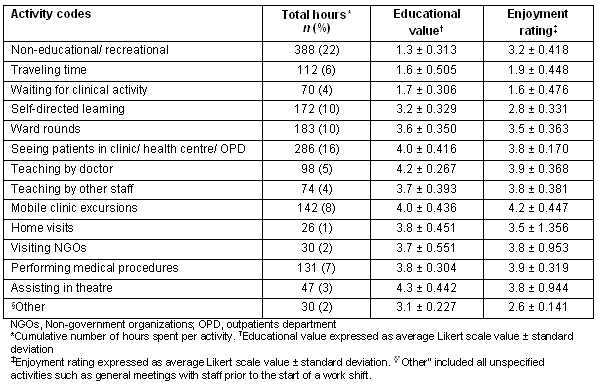
To improve the quantitative part of the assessment students were requested to respond to five opinion testing statements at the end of their rural rotation: two aimed to establish if local supervisors (preceptors) were both punctual and well-prepared. Another two statements aimed to evaluate the acquisition of relevant clinical skills; and a fifth attempted to ascertain if students found the rural rotation enjoyable/ purposeful (Table 2).
We included a formal questionnaire at the end of the log diary (for completion at the end of the rural rotation). It included eight open-ended questions and a reflective summary of the experience (Table 3). Formal focus group discussions were conducted with a randomly selected subgroup of students, whether they adequately completed their log diaries or not. Discussions were recorded on a digital voice recorder which was used to prepare formal transcripts of the meetings. In addition, the study coordinator took written field notes during the discussions, identifying the main themes as they emerged. Themes identified were triangulated with the written responses received and included if they were supported by at least 50% of students.
Table 2: Summary of student responses to opinion testing statements
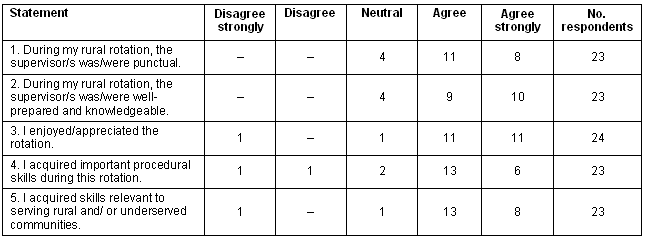
Table 3: Representative quotes from students to open ended questions recorded in the log diary and/or during focus group discussions
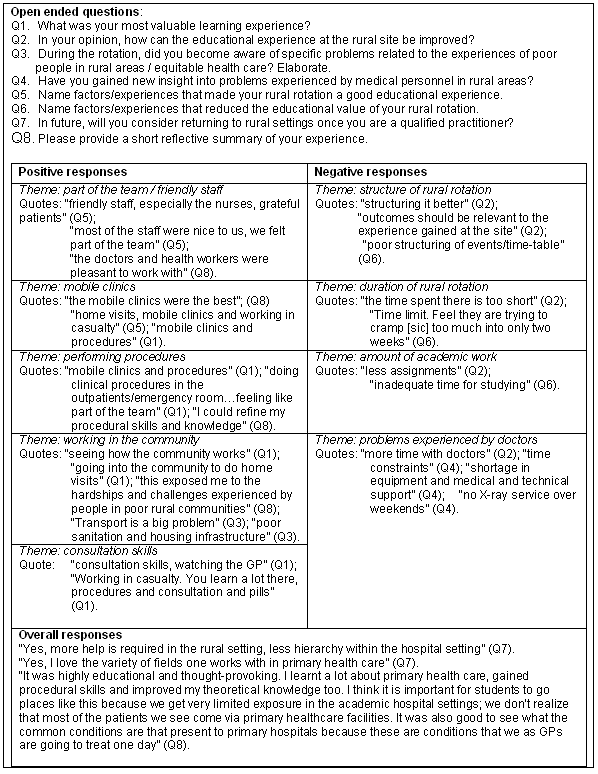
In summary, the diary component (Appendix I) and opinion testing statements included in the log diary were designed as instruments collecting quantitative data; however, the open ended questions and focus group discussions were designed to collect qualitative responses. The results reflect data from both sources as they are complementary and capture different aspects of the students' experiences.
Analysis
Quantitative data from the log diaries were entered into a Microsoft Excel spreadsheet before transfer to GraphPad PrismTM v 4.00 (GraphPad Software, Inc) for analysis. The proportion of time spent on different activities was calculated using the sum of the half-hour segments marked in the diaries. Variability of results is expressed as standard deviations. Likert scale ratings were analyzed as continuous variables. The qualitative feedback was summarized according to the main themes identified by the principal researcher.
Results
Thirty-seven diaries were distributed; 31 (84%) were returned and 25 (68%) were adequately completed for inclusion in the final analysis. All indications of time spent on activities are expressed as percentages of total time (Table 1). The greatest proportion of time was spent on non-educational or recreational activities (22%). Apart from a 30 min lunch break, this was mostly outside formal working hours (08.00 h-16.30 h). The main educational activities included seeing patients (in-service learning;16%), self-directed learning (10%) and training ward rounds (10%). Certain time slots included more than one activity, in which case the 30 min were divided equally between the different activities reported. On average, students spent 6.4 hours/ day on teaching and learning activities and 3.7 hours being directly supervised.
The perceived educational value and enjoyment rating of each activity are shown (Table 1). The following activities were assigned the highest educational values: assisting in theatre (4.3 ± 0.442), teaching by doctor (4.2 ± 0.267), seeing patients in clinic/ health centre/ out patients department (OPD; 4.0 ± 0.416) and mobile clinic excursions (4.0 ± 0.436). The following activities were assigned the highest enjoyment rating: mobile clinic excursions (4.2 ± 0.447), performing medical procedures (3.9 ± 0.319) and teaching by doctor (3.9 ± 0.368). Responses to the 5 opinion testing statements are shown (Table 2). Students experienced supervisors as punctual, well-prepared and knowledgeable. The vast majority (21/24; 88%) enjoyed the rotation, indicating that they acquired important procedural skills that are highly relevant when working in rural and/ or underserved communities.
Table 3 includes representative quotes in response to the open-ended questions, provided at the end of the rural rotation (written feedback) and during the focus group discussions. According to the student feedback received, the most valuable learning experiences were classified under the following five themes: 'feeling part of the team/ friendly staff', 'mobile clinics', 'performing procedures', 'working in the community' and 'consultation skills'.
In terms of their most valuable learning experiences (Table 3), students emphasized the value of performing practical skills and procedures themselves under expert guidance, as well as assisting in theatre (responses to Question 1). Without prompting the students contrasted this to the limited exposure they received at the academic hospital. Students experienced staff and patients to be most friendly and accommodating (responses to Question 5), which contributed to a positive rural experience and influenced their commitment to gain more knowledge; one student referred to 'the friendly face of learning'. Another feature of the focus group discussion was the perception that they were allowed to practice 'real medicine', as opposed to theoretical medicine. As expressed by one student:
The experience was GREAT. It allowed me to actually get the feeling of being a real doctor. I was allowed to handle patients and make a diagnosis on my own (with adequate supervision), everyone (the nurses and doctor) treated me like a colleague.
Students also emphasized the positive influence of good role models in their reflective summaries and one student wrote: '...doctors were really excellent role models with lots of practical clinical experience/ handling common problems'.
Critical feedback was grouped under the following themes: 'structure of the rotation', 'duration of the rotation', 'amount of academic work', and 'problems experienced by doctors'. Question 2 allowed students to suggest how the educational experience could be improved, and Question 6 requested students to name factors or experiences that reduced the educational value of the rural rotation (Table 3). Some responses to these two questions referred to the formal structure of the rural rotation, with student quotes such as 'outcomes should be relevant to the experience' and 'poor structuring of events/ time-table'. Student feedback was unanimous, requesting that the amount of written project work be reduced, increasing the time available to learn more of the required clinical skills. Most students indicated that a time period of 2 weeks was too short for them to benefit optimally from the rotation. In the words of one student:
We were just finding our feet, and now we must pack up and leave again. I feel I should stay here for at least another two weeks, because there is so much to learn.
Discussion
We report the successful use of the log diary approach to documenting how students spend their time on rural clinical rotations. We adapted the instrument to also capture qualitative information regarding the perceived educational value of various activities. During feedback from students and triangulation with supervisors, a major shortcoming identified was the little emphasis placed on after-hours academic activities. Being available after hours to assist with emergency procedures, such as Caesarian sections, was regarded as valuable exposure that was poorly captured by the log diary.
Overall, our results are in agreement with what has previously been reported in the literature, confirming that medical students derive great educational value from well-supervised rural clinical rotations44-46. They also enjoyed the rotations. In contrast to Murray et al.'s findings33 that showed a disassociation between perceived educational value and the enjoyment rating of various activities, our results demonstrated congruence between the most enjoyed activities and those associated with the highest educational value. In terms of educational value, the following activities were rated most educational: 'assisting in theatre', 'teaching by doctor', 'seeing patients in clinic/health centre/OPD' and 'mobile clinic excursions'. With regards to the enjoyment ratings, the following activities were rated most enjoyable: 'mobile clinic excursions', 'performing medical procedures' and 'teaching by doctor'.
During workshops held with the rural academic supervisors and faculty staff members, the high educational value and enjoyment rating attached to 'mobile clinic excursions' came as a surprise, partly because the educators had not had exposure to this activity themselves (because the mobile clinics are exclusively nurse driven). Overall ratings were high for all the clinical activities, but time spent traveling and/ or waiting was viewed as 'wasted time'. This indicates the importance of excellent planning (eg time-tables and transport) to enhance students' experience. The positive outcomes of the workshops held with rural academic supervisors included the ability to provide direct feedback and to triangulate the students' experiences with those of their supervisors, and the assistance provided to interpret responses in context. Feedback provided by the study guided subsequent improvements to the content and defined the outcomes of the Middle Clinical Rotation.
Written responses were often very cryptic. Therefore, focus group discussions added immense value to the interpretation, because many students were able to express themselves best verbally. It also allowed capture of responses from students who failed to complete their log diaries. One student indicated that s/he missed life in the city and will never return to a rural setting. This student declined to document in the log diary, despite assurances of anonymity, demonstrating the importance of triangulation. It also indicates that the analyzed responses may be biased towards recording a positive experience. Similar to our observations, reports in the literature indicate that positive or negative role models are an influence on the ultimate career choices of students47.
In terms of teaching and supervised activities, our results (3.7 hours per day) compare with the situation at University College London, where students receive supervised teaching for 3.5-4 hours/day33. In one US study, however, students reportedly spent 13 hours a day on teaching and learning activities, receiving supervised teaching for approximately 6.5 hours48. Due to changes in the medical education landscape and curricula worldwide49, the educational value of rural rotations requires more intense scrutiny to evaluate appropriate contextualized training in different rural settings. The need for more structured rural rotations is reflected in the qualitative feedback from the students (Table 3), and the negative experience documented in the log diaries, for example wasting time waiting for activities. Of concern is the observation that the largest portions of time are spent on non-clinical activities, while our results indicate that the students derive the greatest educational and enjoyment value from clinical activities. Special attention should be paid to reducing non-clinical activities, especially 'traveling time' and 'waiting for clinical activity', but adequate time should be available for healthy recreational activity. Students spent 10% of their time on 'self-directed learning', but did not find it as educational or enjoyable as 'seeing patients in clinic/ health centre/ OPD'. In future, such time could be better allocated toward clinical activities.
Students indicated that the additional academic load of written reports and projects prevented them from maximizing the rural experience. This specific Middle Clinical Rotation consists of elements from three separate disciplines: (i) family medicine and primary care; (ii) rehabilitation; and (iii) community medicine. Students were unanimous in requesting that the amount of written project work be reduced to increase the time available to acquire clinical skills. The vast majority of students also indicated that a time period of 2 weeks is too short to derive greatest benefit from the rotation.
The present study findings are comparable to previous studies performed in Africa. A study in Ethiopia identified the need to develop students' group skills, prepare mentors to facilitate learning, optimize scheduling and improve study facilities36. Egyptian students displayed a preference for passively acquired information, although they indicated a willingness to increase their own involvement in learning50. In terms of a broader contribution of community-based settings to medical education, the potential for collaboration between community-based health programs and institutions of higher education have been described in Kenya (COBES network)51. They also introduced a theoretical framework to facilitate this type of learning collaboration in developing countries51. Collaborations among African institutions and universities from the UK and USA were also reported as successful52-53, but most of these reports utilized cross-sectional retrospective surveys to assess students' learning experiences. The unique feature of the present study is the fact that we used both quantitative and qualitative modes of enquiry. This, together with the use of prospective data collection by students using the log diary approach, increased the scientific rigour of the methodology and allowed triangulation of data from different sources and demonstrated complementary findings.
Conclusion
This study evaluated the perceived educational experience of medical students during a rural clinical rotation by use of a log diary. Our results support the use of the log diary as both a quantitative and qualitative instrument to evaluate the educational experience of students, although it may benefit from some adjustments. The study demonstrates that students enjoy the experience and value the educational exposure of working in well-functioning rural health care centers with adequate local supervision and guidance.
Acknowledgements
The authors would like to thank the following people for their logistical support: Mrs Lindsay Meyer, Ms Denise Williams, Ms Freda Valentine, Mrs Myrna van Zyl and Ms Colleen Warrington. The project was funded by the Fund for Innovation and Research into Teaching and Learning (FIRLT), from the Centre for Teaching and Learning at Stellenbosch University.
References
1. Evans PR. Profile of the professions: a portrait of the discipline of general practice/family medicine. Journal of Interprofessional Care 2004; 18(3): 313-315.
2. WHO. Primary health care. A joint report by WHO and UNICEF: International Conference on Primary Healthcare, Alma Ata, during 1978. Health for All, series no1, Geneva: WHO; 1980.
3. Robinson MD. Family Medicine: care for a lifetime. Annals of Family Medicine 2007; 5: 567-568.
4. Pipas CF, Peltier DA, Fall LH, Olson AL, Mahoney JF, Skochelak SE, Gjerde CL. Collaborating to integrate curriculum in primary care medical education: successes and challenges from three US medical schools. Family Medicine 2004; 36: S126-S132.
5. WONCA Europe. The European definition of general practice/family medicine. London: Wonca Europe; 2002.
6. Bundesministerium für Frauen, Jugend und Gesundheit. Gesundheitsreform 2000 [Health Care Reform 2000]. Berlin: Bundesministerium für Frauen, Jugend und Gesundheit; 2000.
7. Aguzzoli F, Aligon A, Com-Ruelle L, Frerot L. Choosing to have a referring physician: an analysis made from the first implementation in the beginning of 1998. Paris: CREDES, 1999.
8. Le Grand J, Mays N, Mulligan JA (Eds). Learning from the NHS internal market: a review of the evidence. London: King's Fund, 1998.
9. Maree J, Groenwegen P. Back to Bismarck: Eastern European health care systems in transition. Aldershot: Avebury, 1997.
10. Goldstein E, Preker A, Adeyi O, Chellaraj G. Trends in health status, services and finances: the transition in central and Eastern Europe, vol 1. Washington, DC: The World Bank, 1996.
11. Mckee M. Health services in Central and Eastern Europe: past problems and future prospects. Journal of Epidemiology and Community Health 1991; 45: 260-265.
12. Vohlonen I, Perkurinen M, Saltman RB. Re-organising primary medical care in Finland. The Personal Doctor Program Health Policy 1989; 18: 65-79.
13. Hellenberg DA, Gibbs T, Megennis S, Ogunbanjo GA. Family medicine in South Africa: where are we now and where do we want to be? European Journal of General Practice 2005; 11(3-4): 127-130.
14. De Villiers PJT. Family Medicine as a new speciality in South Africa. South Africa Family Practice 2004; 46(1): 3.
15. Mash B, De Villiers M. Community-based training in Family Medicine - a different paradigm. Medical Education 1999; 33: 725-729.
16. Shipengrover JA, James PA. Measuring instructional quality in community-orientated medical education: looking into the black box. Medical Education 1999; 33: 846-853.
17. Barr DM, Wollstadt LJ, Goodrich LL, Pittman JG, Booher CE, Evans RL. The Rockford School of Medicine undergraduate quality assurance program. Journal of Medical Education 1976; 51(5): 370-377.
18. Friedman CP, Baker RM, Ilderton EP. Functions of a family medicine preceptorship. Journal of Medical Education 1979; 54(7): 567-575.
19. Kumpusalo E, Tuomilehto J. Teaching of primary health care in practice: a model using local health centres in undergraduate medical education. Medical Education 1987; 21(5): 432-440.
20. Al-Dabbagh SA, Al-Taee WG. Evaluation of a task-based community oriented teaching model in family medicine for undergraduate medical students in Iraq. BMC Medical Education 2005; 22(5): 31.
21. Macdonald J. A survey of staff attitudes to increasing medical undergraduate education in a district general hospital. Medical Education 2005; 39(7): 688-695.
22. Parry J, Mathers J, Al-Fares A, Mohammad M, Nandakumar M, Tsivos D. Hostile teaching hospitals and friendly district general hospitals: final year students' views on clinical attachment locations. Medical Education 2002; 36(12): 1131-1141.
23. Lennox A, Petersen S. Development and evaluation of a community-based, multi-agency course for medical students: descriptive survey. BMJ 1998; 6: 461-464.
24. Grant J, Ramsay A, Bain J. Community hospitals and general practice: extended attachments for medical students. Medical Education 1997; 31: 364-368.
25. Habbick BF, Leeder SR. Orienting medical education to community need: a review. Medical Education 1996; 30: 163-171.
26. Driessen E, Van Tartwijk J, Van der Vleuten C, Wass V. Portfolios in medical education: why do they meet with mixed success? A systematic review. Medical Education 2007; 41(12): 1224-1233.
27. Srinivasan M, Hauer KE, Der-Martirosian C, Wilkes M, Gesundheit N. Does feedback matter? Practice-based learning for medical students after a multi-institutional clinical performance examination. Medical Education 2007; 41(9): 857-865.
28. Smith SR, Goldman RE, Dollase RH, Taylor JS. Assessing medical students for non-traditional competencies. Medical Teaching 2007; 22: 1-6.
29. Grant A, Robling M. Introducing undergraduate medical teaching into general practice: an action research study. Medical Teaching 2006; 28(7): e192-e197.
30. Michener JL, Parkerson GR Jr, Munning KA. Clinical skills acquired during a clerkship in family medicine. Journal of Medical Education 1986; 61(10): 808-815.
31. Webster R. Undergraduate teaching in primary medical care. Australian Family Physician 1979; 8(7): 808-813.
32. Boendermaker PM, Ket P, Düsman H, Schuling J, Van der Vleuten CP, Tan LH. What influences the quality of educational encounters between trainer and trainee in vocational training for general practice? Medical Teaching 2002; 24(5): 540-543.
33. Murray E, Alderman P, Coppola W, Grol R, Bouhuijs P, Van der Vleuten C. What do students actually do on an internal medicine clerkship? A log diary study. Medical Education 2001; 35(12): 1101-1107.
34. Schamroth AJ, Haines AP, Gallivan S. Medical student experience of London general practice teaching attachments. Medical Education 1990; 24(4): 354-358.
35. Munro JG. Computer analysis of the student log diary: an aid in the teaching of general practice and family medicine. Medical Education 1984; 18(2): 75-79.
36. Salmon K, Keneni G. Student nurses' learning on community-based education in Ethiopia. Education in Health (Abingdon) 2004; 17(2): 172-182.
37. Zorzi A, Rourke J, Kennard M, Peterson M, Miller K. Combined research and clinical learning make rural summer studentship program a successful model. Rural and Remote Health; 5: 401. (Online) 2005. Available: www.rrh.org.au (Accessed 29 July 2008).
38. Newbury JW, Shannon S, Ryan V, Whitrow M. Development of 'rural week' for medical students: impact and quality report. Rural and Remote Health; 5: 432. (Online) 2005. Available: www.rrh.org.au (Accessed 29 July 2008).
39. Critchley J, DeWitt DE, Khan MA, Liaw S. A required rural health module increases students' interest in rural health careers. Rural and Remote Health; 7: 688. (Online) 2007. Available: www.rrh.org.au (Accessed 29 July 2008).
40. Kirby BA, The rural rotation in a medical technology program: a ten-year retrospective study. Clinical Laboratory Science 2007; 20(4): 202-209.
41. Wilkinson D, Birks J, Davies L, Margolis S, Baker P. Preliminary evidence from Queensland that rural clinical schools have a positive impact on rural intern choices. Rural and Remote Health; 4: 340. (Online) 2004. Available: www.rrh.org.au (Accessed 29 July 2008).
42. Worley P, Prideaux D, Strasser R, March R, Worley E. What do medical students actually do on clinical rotations? Medical Teaching 2004; 26(7): 594-598.
43. Igumbor EU, Kwizera EN. The positive impact of rural medical schools on rural intern choices. Rural and Remote Health2005; 5(2): 417.
44. Worley P, Silagy C, Prideaux D, Newble D, Jones A. The Parallel Rural Community Curriculum: an integrated clinical curriculum based in rural general practice. Medical Education 2000; 34: 558-565.
45. Kamien M. A comparison of medical student experiences in rural specialty and metropolitan teaching hospital practice. Australian Journal of Rural Health 1996; 4(3): 151-158.
46. Price DA, Miflin BM, Mudge PR, Jackson CL. The quality of medical teaching and learning in rural settings: the learner's perspective. Medical Education 1994; 28(3): 239-251.
47. Schafer S, Shore W, French L, Tovar J, Hughes S, Hearst N. Rejecting family practice: why medical students switch to other specialties. Family Medicine 2000; 32(5): 320-325.
48. Calhoun JG, Davis WK, Erlandson EE, Maxim BR. A multi-site comparison of student activities in the surgery clerkship. Surgery 1982; 91(6): 622-627.
49. Jones R, Higgs R, De Angelis C, Prideaux D. Changing face of medical curricula. Lancet 2001; 357: 699-703.
50. El-Awady el-SE, Moss S, Mottram D, O'Donnell J. Student perspectives on pharmacy curriculum and instruction in Egyptian schools. American Journal of Pharmacy Education 2006; 70(1): 9.
51. Pemba SK, Kangethe S. Innovative medical education: sustainability through partnership with health programs. Education Health (Abingdon) 2007; 20(1): 18.
52. Kemp J, Tindiweegi J. Nurse education in Mbarara, Uganda. Journal of Advances Nursing 2001; /b>33(1): 8-12.
53. Risley B, Foley RP, Nooman ZM, Richards RW, Ezzat E, Maklady F. A collaboration between two innovative medical education programmes in Egypt and the United States. Medical Education 1989 23(4):333-338.
__________________________
Appendix I: Sample page of the anonymous log diary used in this study

